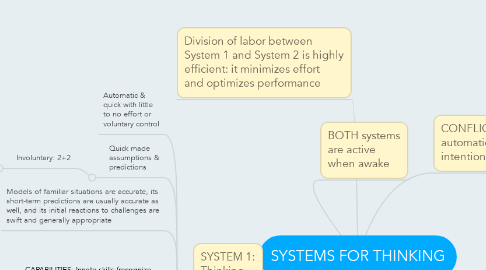
1. SYSTEM 1: Thinking Fast
1.1. Automatic & quick with little to no effort or voluntary control
1.2. Quick made assumptions & predictions
1.2.1. Involuntary: 2+2
1.2.1.1. Susceptible to Voluntary Control: Chewing Gum (Control of Attention is shared by 2 systems
1.3. Models of familiar situations are accurate, its short-term predictions are usually accurate as well, and its initial reactions to challenges are swift and generally appropriate
1.4. CAPABILITIES: Innate skills (recognize objects), other mental activities become part of S1 by prolonged practice, learned associations between ideas, learned skills (reading & understanding social nuances some skills acquired by experts (chess), widely shared (knowledge of culture)
1.4.1. Attention can be moved away from an unwanted focus, primarily by focusing intently on another target
1.4.2. Continuously generates suggestions for System 2 impressions, intuitions, intentions, and feelings
1.4.3. Generates complex patterns of ideas
1.4.3.1. i.e. Relative Distance
1.5. LIMITS: Can not be controlled
1.5.1. Can not be turned off
1.5.2. Has biases - systematic errors that it is prone to make in specified circumstances (sometimes answers easier questions than the one it was asked, and it has little understanding of logic and statistics.)
2. & S2
2.1. If S1 is endorsed by System 2, impressions and intuitions turn into beliefs, and impulses turn into voluntary actions.
3. BOTH systems are active when awake
4. Division of labor between System 1 and System 2 is highly efficient: it minimizes effort and optimizes performance
5. SYSTEM 2: Thinking Slow
5.1. Allocates attention to effortful mental activities that demand complex computations - agency, choice, concentration
5.2. Vague intuitive knowledge, could choose whether or not to engage in thought, sequence of steps
5.2.1. 1. Retrieved from memory the cognitive program
5.2.2. 2. Implemented it
5.3. CAPABILITIES: Can construct thoughts in orderly series of steps, one common feature for operations: they require attention and are disrupted when attention is drawn away, can override system 1 by programming the normally automatic functions of attention and memory
5.3.1. Credited with the continuous monitoring of your own behavior (polite while angry)
5.3.2. Mobilized to increased effort when it detects an error about to be made
5.4. LIMITS: Capacity of attention
5.4.1. Multitasking is possible only with easy tasks
5.4.2. Affects social behavior
5.4.3. Intensive focus can make people effectively blind (even to stimuli)
